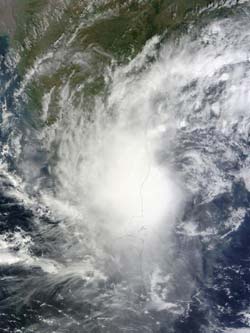NASA sees Tropical Depression Jal's remnants entering and leaving India

NASA\'s Terra satellite flew over Tropical Cyclone Jal at 05:30 UTC (1:30 a.m. EDT) on Nov. 7 as it was making landfall and its eastern half was still in the Bay of Bengal. Credit: NASA/MODIS Rapid Response Team<br><br><br>
This weekend, Tropical Cyclone Jal made landfall in east central India and crossed the northern coast of Tamil Nadu and southern coast of Andhra Pradesh, north of Chennai. It dropped heavy rainfall and created some flooding. Gusty winds were also reported.
NASA's Terra satellite flew over Tropical Cyclone Jal at 05:30 UTC (1:30 a.m. EDT) on Nov. 7 just as it was making landfall and its eastern half was still in the Bay of Bengal.
In the southern coastal districts of Andhra Pradesh evacuations occurred before Jal made landfall. Fortunately, Jal weakened before it made landfall near Chennai.
On Nov. 7 at 1800 UTC (11:30 p.m. local time/India) Tropical Cyclone Jal was about 20 nautical miles north-northeast of Chennai, India near 13.4 North and 80.4 East. It was moving west-northwest near 11 mph and its maximum sustained winds were down to 39 mph (minimum tropical storm-force).
On Sunday, November 7 at 6 p.m. EDT (4:30 a.m. local time/India on Nov. 8) a weather observer in Mahabaleshwar, India (located on the west side of India) emailed NASA and reported gusty winds from Tropical Cyclone Jal had been occurring for two hours even though its center was located near the east coast. Jal weakened into a tropical depression and heavy rainfall moved into Mahabaleshwar as Jal continued moving inland.
Mahabaleshwar is a city and a municipal council in Satara district in the Indian state of Maharashtra, located in the Western Ghats range.
On Monday, Nov. 8 at 2:30 a.m. local time/India, Jal's center was still over land and clouds on is eastern extent were over the Arabian Sea. Jal was centered 25 miles north of Hospet, Karnataka, India.
The Atmospheric Infrared Sounder instrument on NASA's Aqua satellite captured an infrared image of Tropical Cyclone Jal's cold thunderstorm cloud tops on Nov. 7 at 20:41 UTC (7:11 a.m. local time/India on Nov. 8) as its center was moving into the Arabian Sea. At that time, some of the strongest thunderstorms remained over land in western India.
By 8 a.m. EDT (6:30 p.m. local time/India) Nov. 8, the same weather observer who emailed NASA on Nov. 7 reported that the remnants of Jal had not cleared yet. He reported that the entire day was overcast and there were some sprinkles.
The remnants of tropical cyclone Jal are moving into the northeastern Arabian Sea so forecasters are watching it for possible regeneration.
NASA's Hurricane page: www.nasa.gov/hurricane
Media Contact
All latest news from the category: Earth Sciences
Earth Sciences (also referred to as Geosciences), which deals with basic issues surrounding our planet, plays a vital role in the area of energy and raw materials supply.
Earth Sciences comprises subjects such as geology, geography, geological informatics, paleontology, mineralogy, petrography, crystallography, geophysics, geodesy, glaciology, cartography, photogrammetry, meteorology and seismology, early-warning systems, earthquake research and polar research.
Newest articles

Trotting robots reveal emergence of animal gait transitions
A four-legged robot trained with machine learning by EPFL researchers has learned to avoid falls by spontaneously switching between walking, trotting, and pronking – a milestone for roboticists as well…

Innovation promises to prevent power pole-top fires
Engineers in Australia have found a new way to make power-pole insulators resistant to fire and electrical sparking, promising to prevent dangerous pole-top fires and reduce blackouts. Pole-top fires pose…

Possible alternative to antibiotics produced by bacteria
Antibacterial substance from staphylococci discovered with new mechanism of action against natural competitors. Many bacteria produce substances to gain an advantage over competitors in their highly competitive natural environment. Researchers…





















